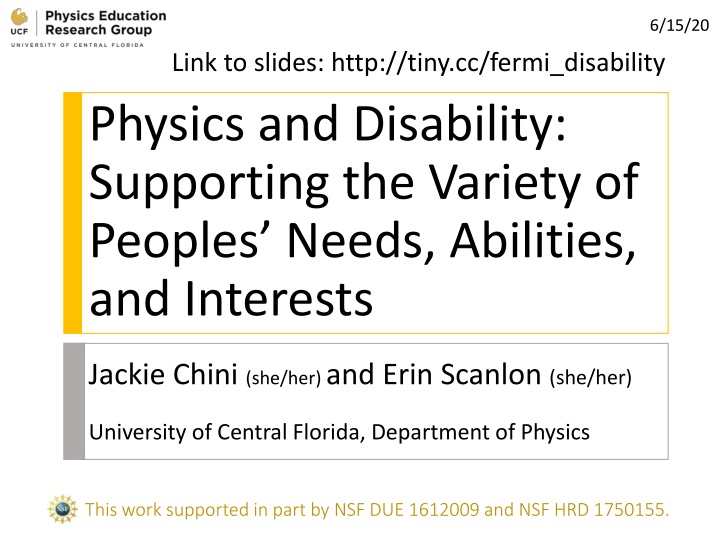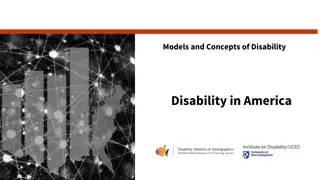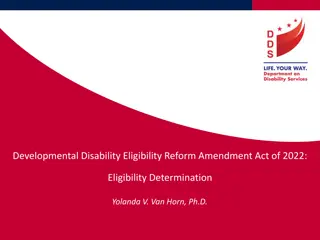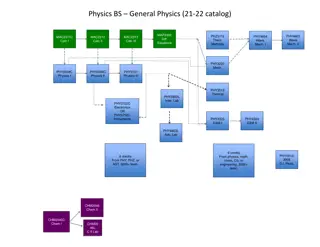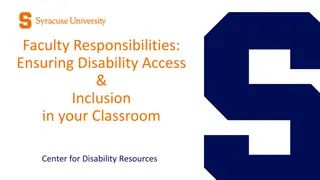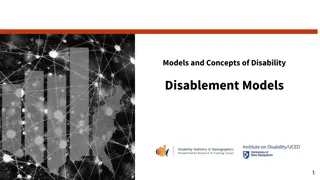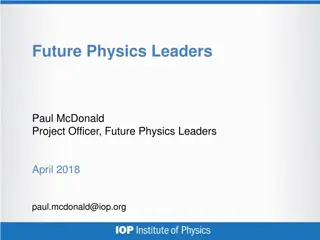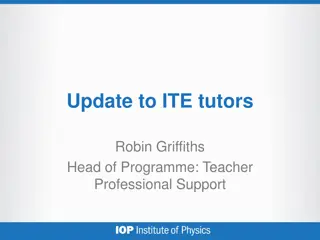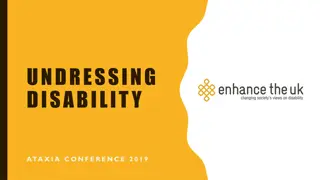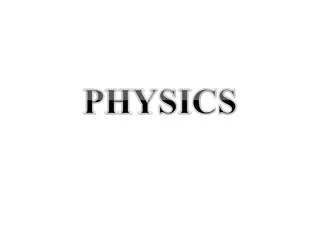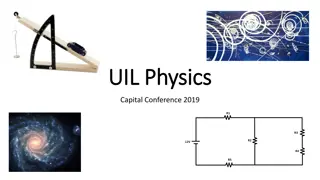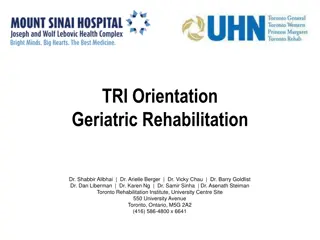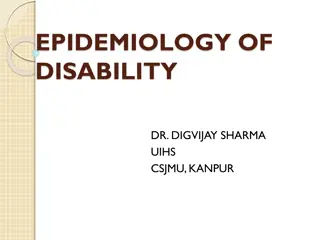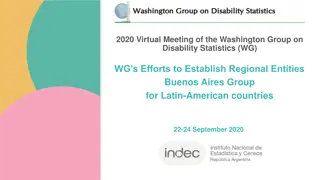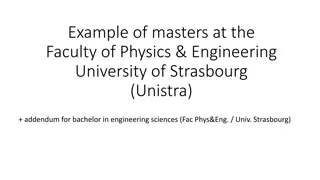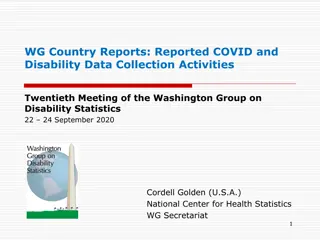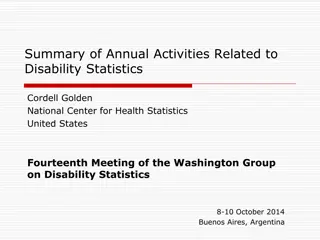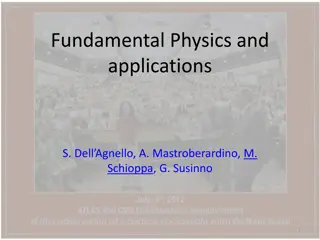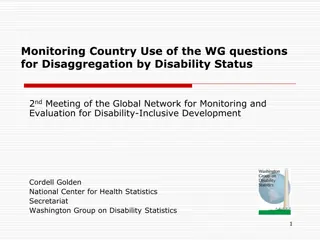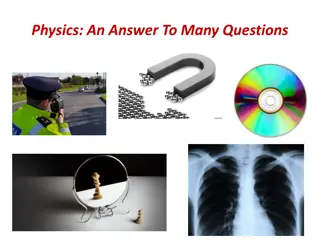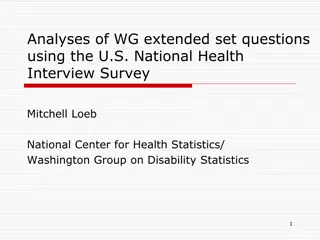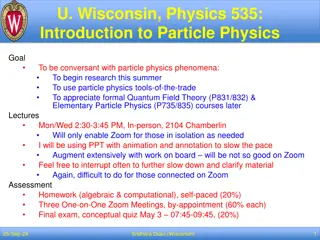Physics and Disability: Supporting Variety of Needs
This presentation explores supporting students and professionals with disabilities in physics education and workforce. It discusses prevalent disability models, statistics on disability representation, and changing diagnoses in higher education. The content covers the importance of inclusivity and accessibility in STEM fields.
Download Presentation

Please find below an Image/Link to download the presentation.
The content on the website is provided AS IS for your information and personal use only. It may not be sold, licensed, or shared on other websites without obtaining consent from the author.If you encounter any issues during the download, it is possible that the publisher has removed the file from their server.
You are allowed to download the files provided on this website for personal or commercial use, subject to the condition that they are used lawfully. All files are the property of their respective owners.
The content on the website is provided AS IS for your information and personal use only. It may not be sold, licensed, or shared on other websites without obtaining consent from the author.
E N D
Presentation Transcript
6/15/20 Link to slides: http://tiny.cc/fermi_disability Physics and Disability: Supporting the Variety of Peoples Needs, Abilities, and Interests Jackie Chini (she/her) and Erin Scanlon (she/her) University of Central Florida, Department of Physics This work supported in part by NSF DUE 1612009 and NSF HRD 1750155.
Poll: Who is here with us today? Poll: Who is here with us today? Indicate your role/position using Zoom poll: Student Person with mainly teaching responsibilities Person with mainly research responsibilities Person with a mixture of teaching and research responsibilities Staff member
Outline Outline Introduction to disability Supporting students with disabilities in the classroom Supporting people with disabilities in the workforce
Our UCF Research Team Our UCF Research Team Postsecondary STEM Educators/Researchers Experts in Exceptional Education Amanda Lannan, Except. Ed grad Roberto Spilka, Biomed. Sci. undergrad Trey Vasquez, Except. Ed faculty Kamryn Lamons, Physics undergrad Jackie Chini, Physics faculty Erin Scanlon, Physics Postdoc Sacha Cartegena, Except. Ex. grad Caroline Bustamante, Health Sci. undergrad Jillian Schreffler, Except. Ed grad Westley James, Physics grad
Two Prevalent Models of Disability Two Prevalent Models of Disability1 1 http://ddsg.org.uk/taxi/medical-model.html http://ddsg.org.uk/taxi/social-model.html 1 Goodley, 2017
People with Disabilities: People with Disabilities: Represent approximately 15% of world s population1 Comprise approximately 10-20% of the postsecondary student population (measured using different definitions of disability categories)2,3 Enroll in science and engineering majors at similar rates as students without disabilities (28% and 27.6%)3 Workforce: Comprise 9.3% of employed physical scientists3 Comprise 3.3% of employed life, physical, and social scientists4 Comprise 9.9% of federal civilian non-postal employees5 1 WHO, 2015 2 Horn, Berktold, & Bobbitt, 1999 3 NSF, 2019 4 BLS, 2020 5 OPM, 2017
Changing Representation of Changing Representation of Disability Diagnoses in Higher Education Disability Diagnoses in Higher Education Mental/Emotional / Behavioral Attention-Deficit Disorder Speech Change in Percent from 1996 30 20 10 Hearing 0 Vision -10 Orthopedic / Mobility -20 Health-related -30 1996 2001 2005 Year 2008 2012 Learning NCES 1996, 2014 Scott, 2009
What are the national and/or institutional protections for people with disabilities? Jot down your thoughts.
Protections for People with Disabilities Protections for People with Disabilities Legal Protections1 Americans with Disabilities Act Rehabilitation Act Telecommunications Act Architectural Barriers Act Fermilab Policies As a federal government contractor, the Laboratory also has the obligation to develop an affirmative action program for individuals with disabilities and protected veterans. 2 Disruptive or harassing behavior shall not be tolerated regardless of race, color, religion, disability, age, gender, veteran status, sexual orientation, gender identity, and/or nationality. 3 1 https://www.ada.gov/cguide.htm 2 Fermilab HR, 2019 3 Fermilab HR, 2017
However However Postsecondary faculty lack awareness about and training to support students with disabilities1-3 STEM curricula are not designed to support students with disabilities4-5 STEM professionals hold negative views about people with disabilities2,6 1 Scott, 2009 2 Norman et al., 1998 3Love et al., 2014 4,5 Scanlon et al., 2018 a,b 6 Rao, 2004
Lets talk about Ableism Jot down your current ideas about ableism: What is it? What does it look like? Where/when does it occur?
Describing Ableism Describing Ableism1 1- -3 3 Discrimination or prejudice in favor of able-bodied people Beliefs that able-bodied people: are inherently superior to disabled people possess essential qualities to participate in normal society should be designed for; physically, culturally, and systemically everything we do is embedded in society, everything is political physics is steeped in this tradition as well. 4 By default, people are ableist unless they are actively anti-ableist 1 Dolmage, 2017 2 Wolbring, 2007 quoted in Goodley, 2014 3 Baines, 2014 4 Traxler & Blue, 2020
Examples of Ableism in STEM Examples of Ableism in STEM Not using microphones at academic conferences Not having elevator access to all levels of a large experiment Requiring 14 hour days to fully participate and/or to meet deadlines
Supporting Students with Disabilities 1. Ability Profiles 2. Universal Design for Learning
Ability Profiles Toy Model Ability Profiles Toy Model Learner variation1 People have abilities across a multidimensional spectrum Abilities can vary: Within a person across these dimensions Between people along the same dimensions Day to day Across contexts 1 Scanlon & Chini, 2018
How do ability profiles affect physics teaching and lab design? Scanlon & Chini, 2018
Current Accommodations Model Current Accommodations Model A course is developed or lab is set up Peron with a disability works with local office of disability services or human resources Disability service office/human resources gives accommodation list to instructors/PI Alterations are made to the course or lab Repeat for every new accommodation list
Universal Design of Products Universal Design of Products Evolution of OXO peeler for increased accessibility and ease of use1 1 https://www.oxo.com/about
Universal Design for Learning (UDL) Universal Design for Learning (UDL) If a shoe is designed based on the average shoe size, would it be effective for everyone? Who would be the most negatively affected by this? If curriculum and courses are designed for the average student, will they be effective for everyone? UDL recognizes the variability of learners needs, abilities, and interests Plans for this variability rather than the average
Universal Design for Learning Framework Universal Design for Learning Framework1 1 # of Principle Guideline Provide options for: Checkpoints 1. perception 3 Provide Multiple Means of Representation 2. language, mathematical expressions, and symbols 5 3. comprehension 4 4. physical action 2 Provide Multiple Means of Action and Expression 5. expression and communication 3 6. executive function 4 7. recruiting interest 3 Provide Multiple Means of Engagement 8. sustaining effort and persistence 4 9. self-regulation 3 http://udlguidelines.cast.org/ 1 CAST, 2011
Supporting people with disabilities in the workforce Attitudes and Beliefs of Practicing Physicists
Guiding Questions Guiding Questions What assumptions do physicists hold that limit possibilities for participation by the widest range of individuals? What does a physicist have to be able to do? What do physics mentors know and believe about disability/impairment?
Our Study Our Study Investigating practicing physicists : Knowledge about disability diagnoses Beliefs about the viability of physics careers for people with a range of disabilities 208 participants completed the survey Recruited through APS meetings and physics listservs Participants include: Faculty (28%), students (50%) and others (22%) including industry, government worker, and high school teachers People with disabilities (22%), who taught students with disabilities (51%), and who have a family/friend with a disability (47%)
Physicists Knowledge about Disability Physicists Knowledge about Disability Place diagnoses into appropriate category of impairment Hearing Visual Learning/Reading Cognitive Health Physical Mobility Emotional/Mental Health Which category of impairment do the following diagnoses belong in? Color blindness Attention deficit/hyperactivity disorder (ADHD) Depression Migraines
Physicists Knowledge about Disability Physicists Knowledge about Disability Place diagnoses into appropriate category of impairment Commonly Correct: Hearing Visual Emotional/Mental Health Commonly Incorrect: Learning/Reading Cognitive Health Physical Mobility
Beliefs about the Viability of Physics Careers Beliefs about the Viability of Physics Careers Participants identified physics careers that are viable for people with different types of impairments Viable career responses varied by impairment: Cognitive impairments had the lowest number of viable career responses Physics professor was less commonly rated as viable for cognitive and emotional/mental health impairments Theoretical researcher was less commonly rated as viable for learning/reading, cognitive, and emotional/mental health impairments
Role of Mentors in Supporting People Role of Mentors in Supporting People with Disabilities with Disabilities Students have trouble finding mentors with disabilities. They must contend with widespread ignorance, not only about their specific disabilities (whether visible or invisible) but about the Americans with Disabilities Act When they finish their studies, people with disabilities are more likely to pursue STEM careers in the government and less likely than others to go into education. This has implications for visibility, as students are unlikely to know any disabled STEM teachers 1 1 Traxler & Blue, 2020
Ability, like race, is a social construct. The experts are those in power, and their knowledge about not only STEM but about who is able to do STEM comes from them so they remain in power. 1 1 Traxler & Blue, 2020
Who we are prepared to teach and support in the physics community expresses our expectations of who will participate If you don t build it, they won t come
Who we are prepared to teach and support in the physics community expresses our expectations of who will participate People with disabilities are in physics and we aren t supporting them!
Thank you for your attention! Thank you for your attention! These slides: http://tiny.cc/fermi_disability Chini group s relevant papers: tiny.cc/Disability_Papers Our language document: tinyurl.com/ucfperdisabilitylanguage Contact us: Jchini@ucf.edu or Erin.Scanlon@ucf.edu
References References - - 1 1 D. Goodley, Disability Studies: An Interdisciplinary Approach, 2nd ed. (Sage Publications, London, 2017). World Health Organization (2015). WHO global disability action plan 2014-2021: Better health for all people with disability. http://www.who.int/disabilities/actionplan/ L. Horn, J. Berktold, & L. Bobbitt, Postsecondary education descriptive analysis reports: Students with disabilities in postsecondary education: A profile of preparation, participation, and outcomes (Washington, DC: US Department of Education, 1999). https://nces.ed.gov/pubs99/1999187.pdf National Science Foundation, National Center for Science and Engineering Statistics, Women, Minorities, and Persons with Disabilities in Science and Engineering: 2019. Special Report NSF 19-304, (2019). https://ncses.nsf.gov/pubs/nsf19304/ U.S. Bureau of Labor Statistics (2020). Persons with a disability: Labor force characteristics 2019. https://www.bls.gov/news.release/pdf/disabl.pdf
References References - - 2 2 U.S. Office of Personnel Management (2017). Profile of Federal Civilian Non-Postal Employees. https://www.opm.gov/policy- data-oversight/data-analysis-documentation/federal- employment-reports/reports-publications/profile-of-federal- civilian-non-postal-employees/ National Center for Education Statistics. (1996). 1995-96 national postsecondary student aid study (NPSAS:96), undergraduate data analysis system. Washington, DC: U.S. Department of Education. National Center for Education Statistics. (2014). Profile of undergraduate students: 2011 2012 (No. NCES 2014 167). Washington, DC: U.S. Department of Education. https://nces.ed.gov/pubs2015/2015167.pdf G. A. Scott, Higher education and disability: Education needs a coordinated approach to improve its assistance to schools in supporting students. Government Accountability Office, 10(33), 1-51 (2009). https://www.ada.gov/cguide.htm
References References - - 3 3 Fermilab (2015). Affirmative Action Program. https://diversity.fnal.gov/wp- content/uploads/2019/10/affirmativeaction.pdf Fermilab (2017). Statement of Community Standards. https://directorate-docdb.fnal.gov/cgi- bin/RetrieveFile?docid=174 K. Norman, D. Caseau, & G. P. Stefanich, Teaching students with disabilities in inclusive science classrooms: Survey results. Science Education, 82(2), 127-146 (1998). T. Love, N. Kreiser, E. Camargo, M. Grubbs, E. Kim, P. Burge, & S. Culver, STEM Faculty experiences with students with disabilities at a Land Grant Institution. Journal of Education and Training Studies, 3(1), 27-38 (2014). E. Scanlon, J. Schreffler, W. James, E. Vasquez, and J. J. Chini, Postsecondary physics curricula and Universal Design for Learning: Planning for diverse learners, Phys. Rev. Phys. Ed. Res. 14, 020101 (2018).
References References - - 4 4 E. Scanlon, T. Legron-Rodriguez, J. Schreffler, E. Ibadlit, E. Vasquez, & J. J. Chini, Postsecondary chemistry curricula and Universal Design for Learning: Planning for variations in learners abilities, needs, and interests, Chemistry Education Research and Practice19, 1216 (2018). S. Rao, Faculty attitudes and students with disabilities in higher education: A literature review, College of Student Journal38 (2004). J. T. Dolmage, Academic Ableism: Disability and Higher Education (University of Michigan Press, Ann Arbor, 2017). Retrieved from www.press.umich.edu/9708836/academic_ableism G. Wolbring (2007), quoted in D. Goodley, Dis/ability Studies Theorising disablism and ableism, Routledge(2014). https://doi.org/10.4324/9780203366974 A.D. Baines, (Un)Learning Disability: Recognizing and Changing Restrictive Views of Student Ability, Teachers College Press (2014).
References References - - 5 5 A. Traxler, & J. Blue (2020). Disability in Physics: Learning from Binary Mistakes. https://link.springer.com/chapter/10.1007/978-3-030- 41933-2_8 E. M. Scanlon and J. J. Chini, Ability Profiles: A Framework for Conceptualizing Dimensions of Ability, 2018 PERC Proceedings [Washington, DC, August 1-2, 2018], edited by A. Traxler, Y. Cao, and S. Wolf, DOI: https://doi.org/10.1119/perc.2018.pr.Scanlon https://www.oxo.com/about CAST (2011). Universal Design for Learning Guidelines version 2.0. Wakefield, MA: Author.
